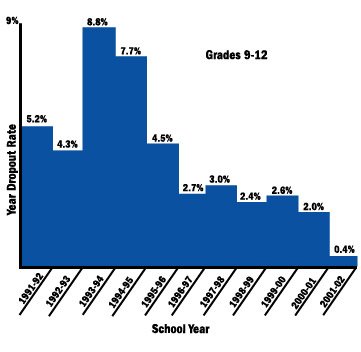GILROY
– Gilroy public schools recorded their lowest dropout rates in
10 years as the number of students who leave ninth through 12th
grades each year is approaching ever closer to zero, according to a
state report released this week.
Eleven Gilroy Unified School District high school students
– less than half a percent (0.4 percent) – dropped out during
the 2001-02 school year. The figure is lower than the roughly 2
percent of students that dropped out in 2000-01.
Just eight years ago, the GUSD dropout rate was 8.8 percent. The
most recent decline represents the second drop in the last three
years and is part of a four-year countywide decline in
dropouts.
GILROY – Gilroy public schools recorded their lowest dropout rates in 10 years as the number of students who leave ninth through 12th grades each year is approaching ever closer to zero, according to a state report released this week.
Eleven Gilroy Unified School District high school students – less than half a percent (0.4 percent) – dropped out during the 2001-02 school year. The figure is lower than the roughly 2 percent of students that dropped out in 2000-01.
Just eight years ago, the GUSD dropout rate was 8.8 percent. The most recent decline represents the second drop in the last three years and is part of a four-year countywide decline in dropouts.
“This speaks well of the alternative programs in the district like Mt. Madonna High School, Community Day School and El Portal (a charter high school),” said GUSD Superintendent Edwin Diaz. “It shows we’re keeping better track of our students and that we’re giving them options.”
GHS is the only high school in the district to report any dropouts. Out of 2,313 students, 11 left the school without joining another educational program, such as independent study or adult schooling.
Gilroy’s dropout rate had one of the sharpest drops in the Bay Area. Its 0.4 percent dropout rate was bested only by the Palo Alto and New Haven school districts. However, New Haven’s decline was not as large as GUSD’s and Palo Alto saw a slight increase in its dropout rate.
“As with any type of improvement, it’s hard to pinpoint why there was improvement,” Diaz said. “It’s almost never a cause and effect of one program, but a combination of a number of things.”
The latest state records corroborate anecdotal evidence from GHS teacher Jose Hernandez. Hernandez, in his third year with the district, also serves as adviser for the Latinos program – a club focusing on improving grades and increasing involvement of Hispanic males.
“There were 90 Latino students who showed improvement in things like grades and attendance this last quarter,” Hernandez said. “I credit the school for its overall push and focus on academics, but the Latinos program makes kids feel like someone is looking after them.”
More improvement and another dropout rate decline could be forthcoming. Hernandez said out of 10 seniors last year, three graduated. Of his 10 seniors this year, seven will graduate.
Keeping Hispanic students enrolled through graduation is critical if GUSD is serious about having zero dropouts some day. The state’s most recent data reveals that Hispanics were the only ethnic group in GUSD to have dropouts.
Diaz said the state’s accountability system, despite its mix of pros and cons, is helping the school district focus on improving the performance of Hispanic students. The state requires schools to show yearly improvement on standardized tests and makes them track progress of subgroups like English Language Learners, economically disadvantaged students and Hispanics.
“There’s a real emphasis to keeping track of kids and keeping them in the system,” Diaz said. “We’ve improved attendance, and we’re identifying students who are habitually truant and giving them whatever intervention meets their needs.”
Diaz acknowledged the district can still do a more thorough job in tracking its students. For instance, this year’s senior GHS class of about 470 students entered the school as a freshman class of roughly 600. Diaz said some of those students are now enrolled elsewhere in the district, but it’s likely some are not.
“You’d think normal attrition, like kids moving out of the state, would be a wash when new students move in,” Diaz said. “We really need to look at doing some long-term analysis of that.”
Hernandez and the Latinos program has identified its own method of keeping students focused on graduation.
“We’re working on fund raisers so we can pay for seniors who want to go to their Grad Nite Disneyland trip but can’t afford the $145 ticket,” Hernandez said. “It might not be academic, but we’re trying to create whatever incentive works.”














